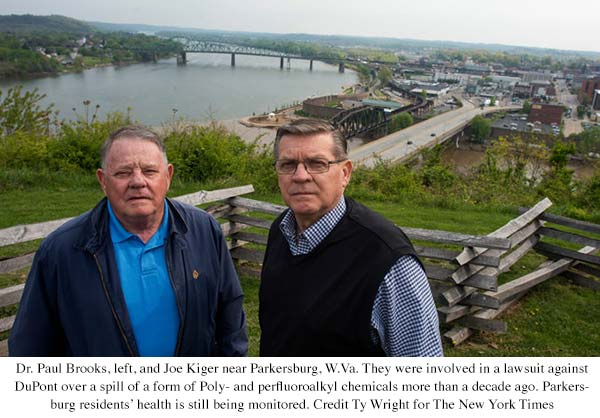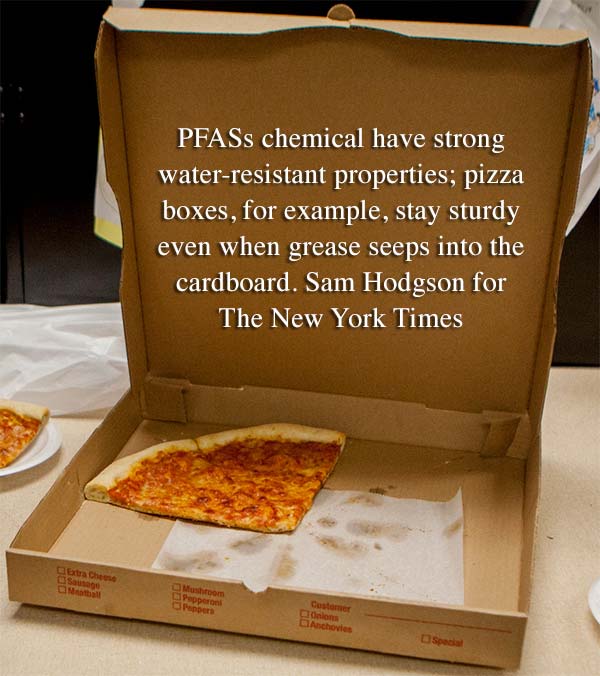Hazardous Chemicals In Cell Phones, Pizza Boxes, Backpacks Said To Be Health Threat
- By Amy Capetta - May 1, 2015
Think the only bad-for-you ingredient in this box of pizza is the pepperoni? Think again. (Photo: Getty Images)
Hundreds of environmental scientists have joined forces to begin a public campaign to urge countries around the world — including the United States — to limit their use of a class of chemicals known as poly- and perfluoroalkyl substances, or PFASs.
While one type of this chemical has been banned for years — studies had shown that the PFAS formerly found in Teflon products may have contributed to higher risks of cancer — scientists have reason to believe that the replacement PFASs could also be toxic.
And, according to the scientists, this is a huge cause for concern, since these chemical are found in thousands of products used in everyday life by millions of consumers.
PFASs enable objects to be resistant to high temperatures, ultimately increasing durability and in some cases, preventing fires in wiring and gauges found in vehicles such as cars and planes. A few of the other items that contain these PFASs include pizza boxes, sleeping bags, electronics (like cell phones and hard disk drives), as well as backpacks, footwear and even hospital equipment (it can be found in stents, needles and pacemakers, along with hospital gowns and divider curtains). A complete list can be found here.
Related: Why Ramen Noodles Could Cut Your Life Short
“Research is needed to understand the potential for adverse health effects from exposure to the short-chain PFASs, especially regarding low-dose endocrine disruption and immunotoxicity,” wrote the authors Linda S. Birnbaum, from the National Institute of Environmental Health Sciences and National Toxicology Program and Philippe Grandjean, from the Harvard School of Public Health, in an article published in the recent edition of the journal Environmental Health Perspectives.
“In parallel, research is needed to find safe alternatives for all current uses of PFASs. The question is, should these chemicals continue to be used in consumer products in the meantime, given their persistence in the environment? And, in the absence of indisputably safe alternatives, are consumers willing to give up certain product functionalities, such as stain resistance, to protect themselves against potential health risks? These conundrums cannot be resolved by science alone but need to be considered in an open discussion informed by the scientific evidence,” wrote the authors.
Related: Can Makeup And Cleaning Products Really Mess With Your Hormones?
However, the American Chemistry Council states that these chemicals were deemed safe by the Environmental Protection Agency. “But we just believe based on the 10-year history of extensive studies done on the alternatives, that the regulatory agencies have done their job of determining that these things are safe for their intended uses,” Thomas H. Samples, DuPont’s head of risk management for the division that manufactures these chemicals, told The New York Times, posted below. DuPont is one of the lead manufacturers of this chemical.
“It’s likely they’re going to have some health effects, it just may take us a while to figure out what it is,” said Thomas F. Webster, a professor of environmental health at Boston University’s school of public health, also told The New York Times. “It might take five or 10 years to really do the research.”
Let’s keep in touch! Follow Yahoo Health on Facebook, Twitter, Instagram, and Pinterest. Have a personal health story to share? We want to hear it. Tell us at This email address is being protected from spambots. You need JavaScript enabled to view it..
Commonly Used Chemicals Come Under New Scrutiny

- By ERIC LIPTON and RACHEL ABRAMSMAY 1, 2015
A top federal health official and hundreds of environmental scientists on Friday voiced new health concerns about a common class of chemicals used in products as varied as pizza boxes and carpet treatments.
The concerted public campaign renews a years-old debate about a class of chemicals known as poly- and perfluoroalkyl substances, or PFASs. After studies showed that some PFASs lingered in people’s bodies for years, and appeared to increase the risks of cancer and other health problems, the chemical manufacturer DuPont banned the use of one type of PFAS in its popular Teflon products, and other companies followed suit.
At issue now are replacement chemicals developed by those manufacturers and used in thousands of products, including electronics, footwear, sleeping bags, tents, protective gear for firefighters and even the foams used to extinguish fires.
The companies assert that the alternatives are safe and vehemently contest the scientists’ contentions, pointing to extensive studies conducted in the last decade or so.
But two separate salvos fired on Friday question whether enough research has been done to justify the chemical industry’s confidence in the safety of this crop of PFASs.

“Research is needed to find safe alternatives for all current uses of PFASs,” Linda S. Birnbaum, the head of the national toxicology program for the Department of Health and Human Services, wrote in a commentary piece published Friday in Environmental Health Perspectives. “The question is, should these chemicals continue to be used in consumer products in the meantime, given their persistence in the environment?”
The journal, published by the National Institutes of Health, devoted several pages to the issue, with articles from researchers and from the industry trade group.
A statement signed by 200 international scientists — environmental health experts, toxicologists, epidemiologists and others — urged countries around the world to restrict the use of PFASs.
“We call on the international community to cooperate in limiting the production and use of PFASs,” the statement said.
In a counterpoint, the American Chemistry Council, the industry trade association, argued that the statement ignored the fact that such chemicals use “essential technology for many aspects of modern life,” and that tests, reviewed by the Environmental Protection Agency, concluded that these alternatives were safer than the chemicals they were replacing.
The PFAS family of chemicals represents an important part of DuPont’s $34.7 billion in sales last year.
Thomas H. Samples, the company’s head of risk management for the division that manufactures these chemicals, rejected the scientists’ concerns.
“We don’t dismiss the right of folks to debate this,” Mr. Samples said. “But we just believe based on the 10-year history of extensive studies done on the alternatives, that the regulatory agencies have done their job of determining that these things are safe for their intended uses.”
This business sector, the fluoro-technology industry, is considerable and reached $19.7 billion in sales in 2013, according to the most recent estimate from the FluoroCouncil, a division of the American Chemistry Council.
This class of chemicals is known for its durability. PFASs have strong water-resistant properties. Cardboard pizza boxes treated with the chemicals, for example, stay sturdy even when grease seeps into them.
But some of these same features worry environmental health specialists because traces of the chemicals linger and have been detected in the bloodstream of a large segment of the population, although typically at low levels. In some cases, detectable levels of the older class chemicals have been declining as major manufacturers have developed alternatives they say are safer.
Some researchers cite lingering concerns about a chemical spill more than a decade ago. The health of residents of Parkersburg, W.Va., is still monitored related to a spill of an older form of PFAS from a nearby chemical plant. A class-action lawsuit accused DuPont, which owned the plant, of knowingly contaminating the residents’ groundwater, and the company faces new accusations, in a separate report being issued Friday by the nonprofit Environmental Working Group, that it is not living up to the terms of a court settlement.
Mr. Samples, from DuPont, which is based in Delaware, disputed any suggestion that it was not complying with those terms.
But Dr. Paul Brooks, who helped conduct a study in the West Virginia case that found probable links between the chemical and health issues like thyroid disease and kidney cancer, said DuPont needed to do more to ensure that local residents were participating in the monitoring program. He said he was not convinced that the alternative chemicals that DuPont and other companies were selling would eliminate the health threat.
“When you have something that is a first cousin or brother-in-law to a chemical that we are certain is carcinogenic, you have to somehow prove that it is safe before you use it — that it is not injurious,” he said. “You just have to be cautious.”
Some environmental scientists point to a chemical called GenX as an example of a newer but questionable alternative. Some studies have linked GenX to short-term symptoms like eye and skin irritation in humans, as well as liver damage in animals. Mr. Samples, of DuPont, which manufacturers GenX, said that the tests involved exposing animals to levels so concentrated that they were intended to cause health complications. He also said the chemical was used in industrial settings, not as an ingredient in consumer products.
Still, environmental and health specialists are urging consumers to avoid products containing PFASs “whenever possible.”
“It’s likely they’re going to have some health effects, it just may take us a while to figure out what it is,” said Thomas F. Webster, a professor of environmental health at Boston University’s school of public health who was an author of a paper seeking more scrutiny of PFASs. “It might take five or 10 years to really do the research.”
Correction: May 1, 2015
An earlier version of a picture caption with this article reversed the identifications of the two men shown. Dr. Paul Brooks was on the left and Joe Kiger on the right.


